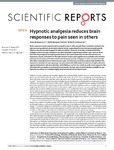Hypnotic analgesia reduces brain responses to pain seen in others
| dc.contributor.author | Braboszcz, Claire | |
| dc.contributor.author | Brandao-Farinelli, E | |
| dc.contributor.author | Vuilleumier, P | |
| dc.date.accessioned | 2017-09-29T08:55:50Z | |
| dc.date.available | 2017-09-29T08:55:50Z | |
| dc.date.issued | 2017-08-29 | |
| dc.identifier.issn | 2045-2322 | |
| dc.identifier.issn | 2045-2322 | |
| dc.identifier.other | 9778 | |
| dc.identifier.uri | http://hdl.handle.net/10026.1/9995 | |
| dc.description.abstract |
<jats:title>Abstract</jats:title><jats:p>Brain responses to pain experienced by oneself or seen in other people show consistent overlap in the pain processing network, particularly anterior insula, supporting the view that pain empathy partly relies on neural processes engaged by self-nociception. However, it remains unresolved whether changes in one’s own pain sensation may affect empathic responding to others’ pain. Here we show that inducing analgesia through hypnosis leads to decreased responses to both self and vicarious experience of pain. Activations in the right anterior insula and amygdala were markedly reduced when participants received painful thermal stimuli following hypnotic analgesia on their own hand, but also when they viewed pictures of others’ hand in pain. Functional connectivity analysis indicated that this hypnotic modulation of pain responses was associated with differential recruitment of right prefrontal regions implicated in selective attention and inhibitory control. Our results provide novel support to the view that self-nociception is involved during empathy for pain, and demonstrate the possibility to use hypnotic procedures to modulate higher-level emotional and social processes.</jats:p> | |
| dc.format.extent | 9778- | |
| dc.format.medium | Electronic | |
| dc.language | en | |
| dc.language.iso | eng | |
| dc.publisher | Springer Science and Business Media LLC | |
| dc.subject | Neurodegenerative | |
| dc.subject | Mind and Body | |
| dc.subject | Chronic Pain | |
| dc.subject | Clinical Research | |
| dc.subject | Complementary and Integrative Health | |
| dc.subject | Neurosciences | |
| dc.subject | Pain Research | |
| dc.subject | 2.1 Biological and endogenous factors | |
| dc.subject | Neurological | |
| dc.title | Hypnotic analgesia reduces brain responses to pain seen in others | |
| dc.type | journal-article | |
| dc.type | Journal Article | |
| dc.type | Research Support, Non-U.S. Gov't | |
| plymouth.author-url | https://www.webofscience.com/api/gateway?GWVersion=2&SrcApp=PARTNER_APP&SrcAuth=LinksAMR&KeyUT=WOS:000408538100020&DestLinkType=FullRecord&DestApp=ALL_WOS&UsrCustomerID=11bb513d99f797142bcfeffcc58ea008 | |
| plymouth.issue | 1 | |
| plymouth.volume | 7 | |
| plymouth.publication-status | Published online | |
| plymouth.journal | Scientific Reports | |
| dc.identifier.doi | 10.1038/s41598-017-10310-4 | |
| plymouth.organisational-group | /Plymouth | |
| dc.publisher.place | England | |
| dcterms.dateAccepted | 2017-07-27 | |
| dc.identifier.eissn | 2045-2322 | |
| dc.rights.embargoperiod | No embargo | |
| rioxxterms.versionofrecord | 10.1038/s41598-017-10310-4 | |
| rioxxterms.licenseref.uri | http://www.rioxx.net/licenses/all-rights-reserved | |
| rioxxterms.licenseref.startdate | 2017-08-29 | |
| rioxxterms.type | Journal Article/Review |


